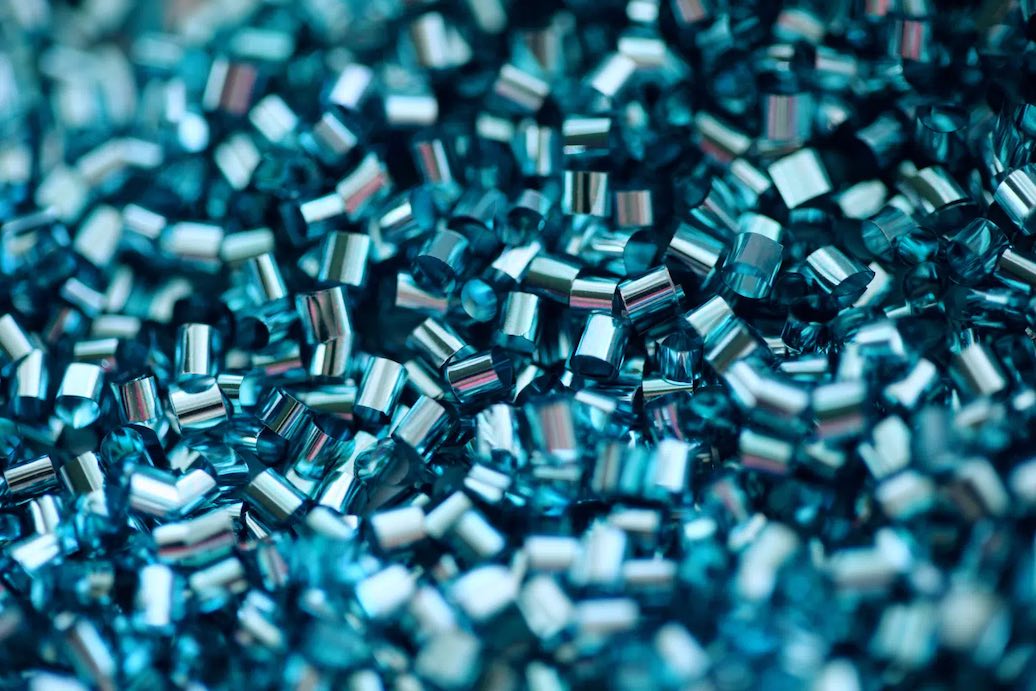
Currently, bioplastics represent only around one percent of the 791 million pounds of plastic produced in 2019. But by 2024, the bioplastics market is expected to increase by 36%, fueled by an urgent need to divest from fossil fuels, the most common feedstock for plastics.
[…] As the appetite for bioplastics grows, it’s worth asking whether this “green” alternative to petroleum-based plastics really is as good as it sounds. Are bioplastics the answer to fashion’s plastic problem?
What are bioplastics?
Bioplastics are made by swapping petroleum for a natural, renewable feedstock. The most common feedstocks on the market include corn, sugarcane (which are fermented to produce polylactic acid or PLA), sugar beets, and castor beans, which are known as first-generation feedstocks. Second-generation feedstocks come from waste materials, and the third generation comes from non-food sources like algae and bacteria. One example of the third generation type is Bloom by the Mississippi-based company Algix, an algae-blended EVA, or synthetic rubber.
Bioplastics fall into two camps: drop-in or new materials. Drop-in bioplastics are essentially a direct replacement for petroleum-based plastic and can be incorporated into existing manufacturing systems, while new materials have to be made and recycled in purpose-built factories. The latter is more expensive and difficult to use, for obvious reasons.
“There are many conventional plastics that can be made as bio-based versions, and they’d have exactly the same application,” says Dr. Ashley Holding, a chemist and the founder and principal consultant of Circuvate. “You can use a bio-based EVA,” ethylene vinyl acetate, “foam to replace petroleum-based EVA foam. “It’s the same material, but it’s coming from bio-based feedstocks.”
Who is using bioplastics in fashion?
While many types of bioplastics are in their early stages of production, there are a few notable uses on the market. In 2018, Brazilian petrochemical company Braskem partnered with footwear brand Allbirds to produce SweetFoam, a biobased EVA that now makes up all of the U.S. brand’s shoe soles. The wider footwear industry has enthusiastically adopted this oft-called “green EVA” after Allbirds made the recipe open source, and it can now be found in the shoes of brands like TOMS, Timberland, Puma and others. Foulkes-Arellano predicts that the entire footwear industry will have transitioned to bio-based soles within the next 10 years.
Glasses are another category where bioplastics have been widely embraced, with brands like Stella McCartney, Monc London, Randolph among the companies working with a wood-pulp-derived bio-acetate that is also biodegradable. (For more on that, read our acetate explainer.)
There are also some exciting innovations happening in the world of third-generation bioplastics, like American designer Phillip Lim’s collaboration with researcher Charlotte McCurdy on bioplastic sequins made from algae, created with textile R&D company Pyrates.
Are bioplastics recyclable, biodegradable or compostable?
It’s impossible to make any general statements about bioplastics, as the sustainability credentials change depending on the feedstock, the type of plastic it’s turned into, where it’s produced, and what it’s replacing. “Just because it’s bio-based doesn’t mean it’s biodegradable, and just because it’s biodegradable doesn’t mean it’s bio-based,” explains Holding. “There are many fossil fuel-based plastics that are biodegradable. In fact, the ones that are mainly used in biodegradable packaging are fossil-fuel based. It’s down to the chemical structure of the polymer itself and not the feedstock it comes from.”
Where will all this feedstock come from?
[…] One concern about pivoting to bioplastics revolves around the reliance on agriculture to produce our plastic instead of fossil fuels. “The issue is we don’t want deforestation happening instead of fossil fuel extraction,” says Foulkes-Arellano. “Instead of it being a fossil-fuel plastic crisis, you end up having no trees and an overdemand for timber.”So we can’t rely on one type of feedstock. “We have to be careful to use bits of everything, we can’t just go 100% into trees or 100% into castor beans,” Foulkes-Arellano says. That would be truly imitating nature, to have a diverse and varied eco-system of bioplastic production sources. While research shows that the land share needed for the bioplastics industry will only make up 0.021% of the global agricultural area by 2024, it’s important that it grows sustainably. “Even though the land use share for biosynthetics is very low, solutions to reduce land-use needs and responsible land management are critical as the sector grows in popularity,” a representative for Textile Exchange, a responsible textile non-profit that has a dedicated biosynthetic initiative, said by email. “Overall, there is no “best” feedstock — it depends on the specific local context, production practices, and application.”
